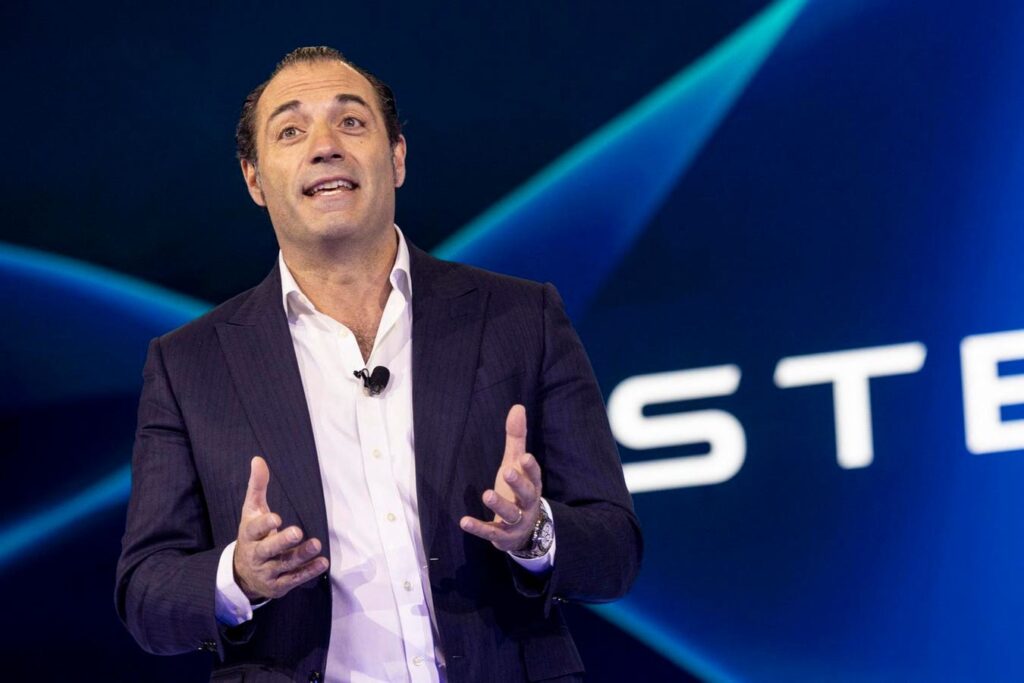New Stellantis CEO Antonio Filosa’s check list includes restoring profitability, negotiating his way around the U.S. tariff upheaval, facing down the electric vehicle revolution, and then figuring out what to do with all those brands.
Stellantis’s operating profit margin in 2024 was 5.5%, down sharply from 2023’s 12.8%. Stellantis had said before the Trump tariffs problems that it expects little improvement in 2025. Last year, industrial cash flow was a negative €6 billion ($6.8 billion) compared with 2023’s positive €12.9 billion ($14.6 billion).
The merger between Fiat Chrysler and France’s Groupe PSA in 2021 was named Stellantis and included 14 brands. Since then a joint venture with LeapMotor of China has been added.
Former CEO Carlos Tavares orchestrated the merger, but shocked shareholders by quitting in December, about a year before the end of his contract. Tavares had been lauded as a financial genius as he welded together many brands which quickly became hugely profitable, despite being mainly mass-market ventures. Overlapping technologies were dropped and economies of scale exploited.
One of the brands, Opel and its British Vauxhall affiliate, had been a chronic loss maker when owned by General Motors. Many of the other European brands including Citroen, Peugeot, Fiat and Lancia competed against other in the mass market. DS, Alfa Romeo and Abarth sit in the wannabe premium sector. Dodge, Ram, Jeep and Chrysler were in the U.S. Storied Italian sportscar maker Maserati sits atop of the list.
Overlapping brands
Tavares had said that because of the apparent overlapping of many of the brands, they would be given 10 years to justify their existence. That expires in 2031, but pressure is likely to amount quickly for them to prove their worth.
Profitability of the various brands was propelled to unprecedented highs by post-covid pandemic supply-constraints. But Tavares’s credibility was undermined by the collapse of profitability in North America. U.S. brands were particularly hard hit when these unusual conditions expired.
Automotive News columnist Jamie Butters said Tavares become “profoundly” unpopular in his last year.
“Pressure on suppliers to bear the costs of electrification led to court battles and missed shipments. Missteps in the U.S. market prompted dealers to call for his resignation. The inability to justify investing in the Belvidere, Ill., plant outraged the UAW, which had counted that plant’s revival as a major win from Shawn Fain’s historic 2023 contract negotiations. Salaried employees weren’t happy either, fielding multiple rounds of buyout offers. So pretty much every stakeholder group was against him,” Butters said.
“After that Filosa (a 25-year company veteran) looks pretty good,” Butters said.
Outsider speculation
There had been speculation that Stellantis would recruit from another company or even another industry. After all the late, great Sergio Marchionne was recruited from outside the automotive industry. Italian luxury sports car maker Ferrari, spun off from Stellantis component Fiat-Chrysler in 2016, reached outside to appoint Benedetto Vigna.
“The decision by John Elkann (provisional Stellantis CEO after Tavares left) and the Ferrari board in 2021 to appoint Benedetto Vigna, who had been running STMicro’s sensors division, as Ferrari CEO has turned out to be inspired, and Vigna has since driven (Ferrari) to ever greater heights,” Bernstein Research said in a report.
“Antonio Filosa also brings a deep understanding of the U.S. market, something which the group’s dealer body persistently accused Carlos Tavares of ignoring its legitimate concerns,” Bernstein Research said.
In Europe the obvious weakling brands are Lancia, Alfa Romeo, and DS. Analysts say at least 10 brands are in dire need of fresh products. Two of them count on only one model. The positioning is not clear either: Opel is very similar to Peugeot. Fiat is very similar to Citroen. Lancia wants to enter the premium segment, where DS and Alfa Romeo are already struggling. Maserati hasn’t been able to find its identity and is stuck somewhere between the premium and luxury segments.
Filosa will have to fix the profit problem and decide what to do with all those brands. Selling some off might well meet willing buyers from China eager to raise their profile in Europe and avoid recently erected high EU tariffs for EVs.
Stellantis, after reporting first quarter sales fell 14% to €35.8 billion ($40.6 billion) compared with the same period last year, said it would not make any predictions about its profits for the year. Stellantis reports profits every six months, not quarterly.
Big decisions needed
Filosa faces big decisions over the next six to 12 months requiring significant strategic adjustments. Cost-cutting measures, better alignment of production with demand, and improved software and electrification strategies will be crucial, analysts say.
HSBC Global Research, in a report on Filosa’s appointment. offered these bullet points –
On paper his CV looks a good fit for the role, given he is:
– An auto guy, having worked exclusively in the industry for over 25 years
– A Italian native from Naples, so understands Europe
– Has spent a good deal of time in South America (Stellantis 3rd largest profit source)
– Lives in Detroit, which is arguably where the heavy lifting needs to be done.
Read the full article here


